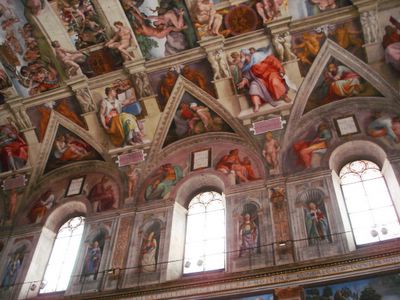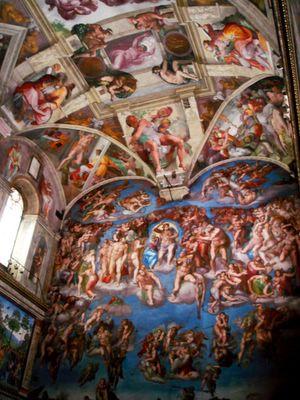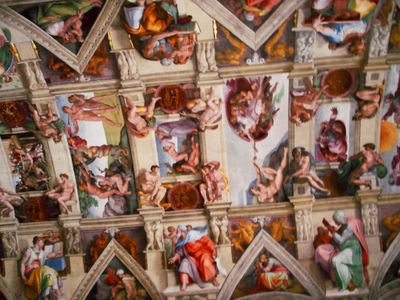We weren't exactly allowed to take pix but I stole a few... it wasn't really the most thrilling or moving experience viewing Michelangelo's masterpiece. It was kind of a 'Mona Lisa - ok, that's over with, next' type of moment. The Sistine Chapel was extremely crowded and the guards kept yelling at everyone to be quiet... it wasn't the most sanctuary space like many of the churches and basilicas. I have to admit that the first I heard about the new Pope being elected in the Sistine Chapel and the whole smoke thing was when I read Dan Brown's 'Angels & Demons' last year but I thought it was pretty interesting when I read it. I'm not Catholic... give me a break.


"The Sistine Chapel is a chapel in the Apostolic Palace, the official residence of the Roman Catholic Pope in the Vatican City. The chapel is rectangular and measures 40.93 meters long by 13.41 meters wide (the dimensions of the Temple of Solomon, as given in the Old Testament). It is 20.70 meters high and is roofed by a flattened barrel vault, with small side vaults over the 6 centered windows.
In 1508 Michelangelo was commissioned by Pope Julius II to paint the vault, or ceiling of the chapel. It took him until 1512 to complete. To be able to reach the ceiling, Michelangelo needed a support; the first idea was by Bramante, who wanted to build for him a special scaffold, suspended in the air with ropes. But Michelangelo suspected that this would leave holes in the ceiling once the work was ended, so he built a scaffold of his own, a flat wooden platform on brackets built out from holes in the wall, high up near the top of the windows. He stood on this scaffolding while he painted.
The first layer of plaster began to grow mold because it was too wet. Michelangelo had to remove it and start again, so he tried a new mixture of plaster, called intonaco, which was resistant to mold. Intonaco was created by one of Michelangelo's assistants, Jacopo l'Indaco. Intonaco is still in use today.
The election of a new Pope, the conclave takes place in the Sistine Chapel. In those occasions a chimney is installed in the roof of the chapel, where the smoke comes out from. If white smoke comes out: a new Pope has been elected. Black smoke: no successful election yet. During present-day meetings of cardinals, the chapel is carefully searched for bugs, recorders, cameras, so that the conclave is kept secret."
[Via Wikipedia]
Monday, May 01, 2006
Michelangelo's Ceiling - Sistine Chapel
Posted by mer at 9:49 PM
Subscribe to:
Post Comments (Atom)


0 comments:
Post a Comment